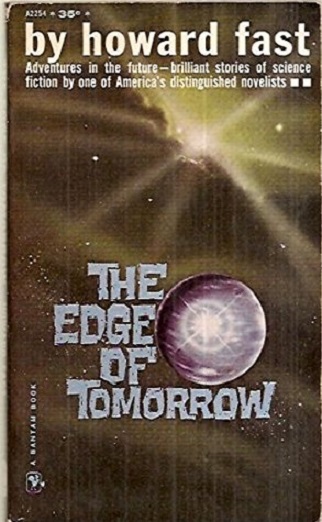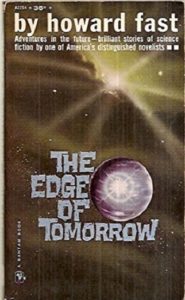Book Review: The Edge of Tomorrow by Howard Fast
There have been several books titled The Edge of Tomorrow, none of which have anything to do with the recent Tom Cruise movie, which borrowed most of its plot from the Japanese light novel All You Need Is Kill. (I think you can see why there was a title change.) This particular volume contains seven science fiction stories by the author of Spartacus and other fine historical novels.
“The First Men” starts in 1945, as Harry Felton is discharged from the Army following World War Two. His anthropologist sister sends a request for him to stay in India for the purpose of finding a child allegedly raised by wolves ala Mowgli. He finds her, but she is mentally unable to function except as a very smart wolf. Similarly, the South African boy raised by baboons is essentially a furless baboon.
Then the actual idea behind Jean’s research is revealed. Children at an early level of development raised by animals can never be more than animals. Children raised by flawed human society will never surpass ordinary humans. But what would happen if a group of highly intelligent infants from around the world were raised under utopian conditions by enlightened scientists?
Harry helps gather the children for this experiment, which must be carried out in complete isolation from the outside world. In 1965, he is called in by the government. It seems all communication with the creche has been lost, and a zone of nothingness has sealed off the area. Does he know what’s going on?
As it happens, Harry has a sealed letter from his sister for just this moment. In it, she reveals that the experiment was highly successful, and the children have taken the next step in mental evolution. Hyperintelligent and telepathic, they are preparing to bring the children of humanity up to their level as fast as they can expand their zone of influence.
Harry’s government contact reacts badly. Not that I can blame him, given the implications.
Some readers may be squicked by discussion of sex among the upraised youngsters. At the time this was written, 1959, certain readers might have been more upset with the idea that all the races of man were equally capable of being uplifted.
“The Large Ant” has a writer on vacation instinctively swatting what appears to be an oversized insect to death. Upon realizing it’s no ordinary insect, he takes it to a museum. It’s not the first specimen they’ve gotten of this type. And given that every human that’s encountered them has immediately defaulted to killing them, we can no longer assume that peaceful contact is possible. Heavy on the infodump.
“Of Time and Cats” has Professor Robert Clyde Bottman, who teaches physics at Columbia University, help out a fellow professor with a defective experimental circuit. As a result, he ties a knot in time, and multiple iterations of himself keep appearing. That gets fixed, but not before his friend’s cat also ties a knot in its own timeline. The best story in this volume, with a humorous touch.
“Cato the Martian” posits a civilization on Mars that has become aware of Earth due to the radio and television waves of the last few decades. One of the members of the Martian Senate is alarmist about the potential for the violent Earthlings to escape their home world and invade Mars. He’s been saddled with the insulting nickname Cato, after the Roman politician who wanted to destroy Carthage.
But Cato has taken the name as his own, and gradually won over most of the Senate to his cause. His plan is to drop atomic bombs on the U.S. and U.S.S.R. to make them think the other has attacked, and start World War Three. Turns out the plan has one fatal flaw….
“The Cold, Cold Box” is a chilling tale of a Board of Directors meeting where they discuss whether or not to continue committing the crime that has brought them to be de facto rulers of the world. By rights, they should turn over power to the person they act on behalf of, but things are running so smoothly without that person. And to be honest, that person was kind of a jerk anyway. A look at how easy it is to salve your conscience with the other good you’ve done.
“The Martian Shop” concerns the opening of three stores allegedly selling products from Mars. It’s really more of a vignette than a story, going into great detail about how the shops were set up, the merchandise they had, how bizarre the shop personnel were, etc. Then there’s a couple of paragraphs at the end revealing what the shops actually are. Between this story and the Cato one, I’m beginning to see where Alan Moore gets his ideas.
“The Sight of Eden” is the final story. An exploratory mission from Earth lands on what appears to be a paradise planet. One that is mysteriously empty. Still, this is the first sign of an inhabitable world they’ve found, and the first sign of other inhabitants of the universe. Then they meet the caretaker and learn why the place is empty. Downer ending.
Overall, decent writing but too reliant on infodumps, and I’ve seen most of these ideas done better. But if you enjoyed Spartacus and want to see what else Howard Fast wrote, this is a handy start.


